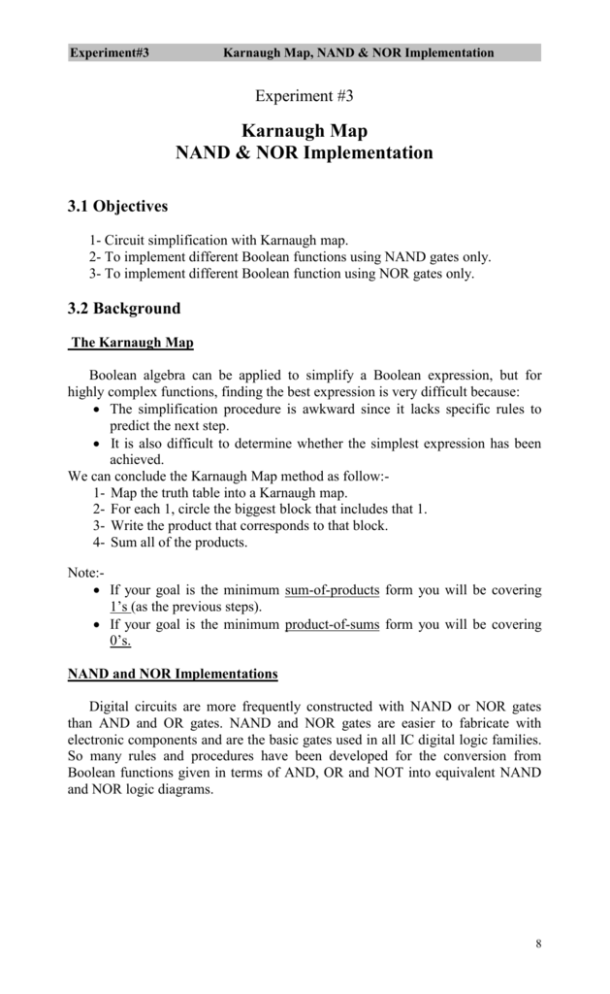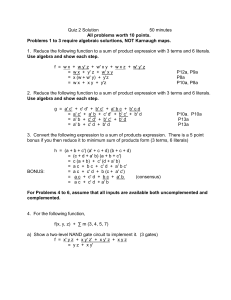Experiment#3 Karnaugh Map, NAND & NOR Implementation
advertisement

Experiment#3 Karnaugh Map, NAND & NOR Implementation Experiment #3 Karnaugh Map NAND & NOR Implementation 3.1 Objectives 1- Circuit simplification with Karnaugh map. 2- To implement different Boolean functions using NAND gates only. 3- To implement different Boolean function using NOR gates only. 3.2 Background The Karnaugh Map Boolean algebra can be applied to simplify a Boolean expression, but for highly complex functions, finding the best expression is very difficult because: The simplification procedure is awkward since it lacks specific rules to predict the next step. It is also difficult to determine whether the simplest expression has been achieved. We can conclude the Karnaugh Map method as follow:1- Map the truth table into a Karnaugh map. 2- For each 1, circle the biggest block that includes that 1. 3- Write the product that corresponds to that block. 4- Sum all of the products. Note: If your goal is the minimum sum-of-products form you will be covering 1’s (as the previous steps). If your goal is the minimum product-of-sums form you will be covering 0’s. NAND and NOR Implementations Digital circuits are more frequently constructed with NAND or NOR gates than AND and OR gates. NAND and NOR gates are easier to fabricate with electronic components and are the basic gates used in all IC digital logic families. So many rules and procedures have been developed for the conversion from Boolean functions given in terms of AND, OR and NOT into equivalent NAND and NOR logic diagrams. 8 Experiment#3 Karnaugh Map, NAND & NOR Implementation I- NAND Implementation The rule for obtaining the NAND logic diagram from a Boolean function has two ways: A) Two-level implementation: 1- Simplify the function and express it in sum of products. 2- Draw a NAND gate for each product term of the function that has at least two literals. The inputs to each NAND gate are the literals of the term. This constitutes a group of first-level gates. 3- Draw a single NAND gate (using AND-inverter or inverter-OR graphic symbol) in the second-level, with inputs coming from outputs of the first-level gates. 4- A term with a single literal requires an inverter in the first level or may be complemented and applied as an input to the second-level NAND gate. NOR Implementation The NOR function is the dual of the NAND function. For this reason, the rule for obtaining the NOR logic diagram form a Boolean function is similar to the NAND rule except that the simplified expression must be in the product of sums and the terms for the first level NOR gates are the sum terms. To obtain the simplified product of sums from a map it is necessary to combine the 0’s in the map and then complement the function. A) Two-level NOR implementation procedure a) Simplify the function in product-of-sums form b) For sum terms with 2 or more literals, use the same input c) For sum terms with a single literal, invert the input d) Draw NOR-NOR as if OR-AND implementation PRELAB: Read the procedures carefully and: 1. 2. 3. 4. Do part I (a), (b), and (c). Do part II (b). Do part III (b). Do part IV (a), (b), and (c). Draw the circuit connection in both logic and pin diagram. (make it clear as possible even you can use colors). 3.4 Lab Work Equipments: 1- 74x00 2-input quad NAND gates. 2- 74x02 2-input quad NOR gates. 9 Experiment#3 Karnaugh Map, NAND & NOR Implementation 3- 74x04 hex inverter. 4- 74x08 2-input quad AND gates. 5- 74x32 2-input quad OR gates. Part I : Karnaugh Map Given the function f1(A,B,C) =∑(1,3, 4,5,7). a) Derive the truth table for f1. b) Simplify f1 using K-map. c) Show in logic diagram and schematic diagram the circuit connections of the simplified function f1. d) Connect the circuits in part (c) and verify the truth table of part (a). Part II : NAND Gate Implementation a) Using the steps of NAND implementation with two-level, implement the function f1 in part I using NAND gates only. b) Show in logic diagram and schematic diagram the circuit connections. c) Connect the circuit in part (b) and derive the truth table experimentally and show that it is the same as that in part I. Part III : NOR Gate Implementation a) Using the steps of NAND implementation with two-level, implement the function f1 in part I using NOR gates only. b) Show in logic diagram and schematic diagram the circuit connections. c) Connect the circuit in part (b) and derive the truth table experimentally and show that it is the same as that in part I. Part IV: Circuit Design A switching network has two control inputs (C1,C2) , two data inputs (X1,X2), and one output Z. If C1 = C2 = 0, the output is Z = 0. If C1 = C2 = 1, the output is Z = 1. If C1 =1 and C2 = 0, the output is Z = X1. If C1 = 0 and C2 = 1, the output is Z = X2. C1 C2 X1 Z X2 a) Derive a truth table for Z. b) Use a Karnaugh map to find a minimum AND-OR gates network to realize Z. c) Draw in logic diagram and schematic diagram the circuit connections of Z. d) Connect the circuit in part (c) and verify the truth table. 10 Experiment#3 Karnaugh Map, NAND & NOR Implementation Exercises: 1. Use a Karnaugh map to find the minimum (SOP) & (POS) form for the expression: F(A,B,C,D) = AB’ + AB’C’D + CD + BC’D + ABCD Then implement the function with NAND gates only. 2. Use a Karnaugh map to find the minimum (SOP) & (POS) form for the expression: F(A,B,C,D) = A’B(C’D’+C’D)+AB(C’D’+C’D)+AB’C’D Then implement the function with NOR gates only. 11







